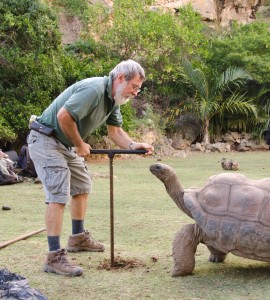Sister Sites
January 12, 2020

Dr. Burney collects a sediment core on Rodrigues Island, while a living fossil, a giant Aldabra tortoise, supervises.
MCR is unique…or is it? All through the years, we have taken inspiration from others around the world who are trying to make that rare but potent combination of fossils, cultural history, and habitat restoration in a spectacular natural setting. In Back to the Future in the Caves of Kaua`i (Yale Press, 2010), I talk about some remarkable “rewilding” efforts, from Ted Turner’s Ladder Ranch in New Mexico, to projects on the Indian Ocean island of Mauritius.
Since that time we have derived inspiration from reciprocal visits and exchange of information with similar projects in Japan, the Netherlands, Madagascar and elsewhere.
In the last few years, I have spent more time working on some of these “sister sites” than at MCR, following my research interests in paleoecology and its many applications to conservation. At the Beanka Protected Area near Ambinda in western Madagascar, our research team has discovered caves with untouched troves of giant lemur bones and spectacular cave art, and consulted on a project to reintroduce giant tortoises from neighboring Aldabra Island. On Mauritius, we have participated in the creation of a new museum exhibit at La Vanille Nature Park and the discovery of a site with the first Ice-Age fossils of the dodo, that iconic bird that was the first historically documented extinction.
My favorite “sister site” is the Francois Leguat Giant Tortoise and Cave Reserve, on tiny Rodrigues Island, isolated far out in the Indian Ocean between Mauritius and Australia, way down in the Southern Hemisphere south of India. Started about the same time as the Makauwahi Cave Reserve, the park’s extensive eolianite caves contain abundant fossils of the solitaire, a giant flightless pigeon larger than the dodo, as well as huge tortoises, giant fruit bats, and other remarkable fauna, mostly extinct or highly endangered. Today the site features re-introduced giant tortoises, a conservation program for the giant bats, and more than 200,000 native trees and shrubs, all planted by local staff. Also like MCR, they host thousands of visitors each year from throughout the world and provide educational experiences at all levels.
Over the last few years, our team has worked on many sites there, and discovered at least one really special new site outside the Reserve. Like Makauwahi Cave, the new site we named Grotte Fougère (Creole for “Fern Grotto”) is extraordinarily rich with almost every kind of fossil imaginable, including bones, seeds, pollen, and even delicate insects. Like MCR, we are working in lake sediments inside the cave, and the record spans thousands of years of mud laid down year-by-year. On Rodrigues, though, humans only arrived about three centuries ago – there was no indigenous population – and the catastrophic extinctions occurred rapidly when people did finally arrive.
So if you are planning a trip to any of these Indian Ocean islands, be sure to see some of these “sister sites.” They’ve taught us so much.